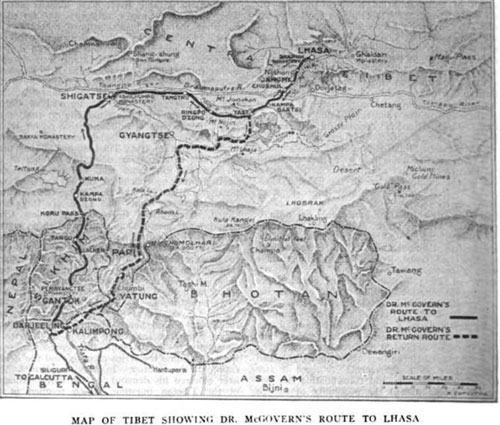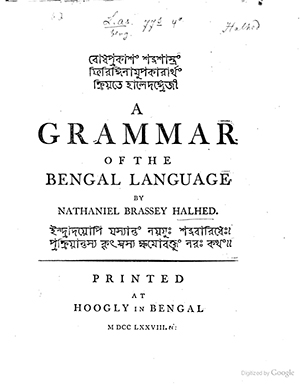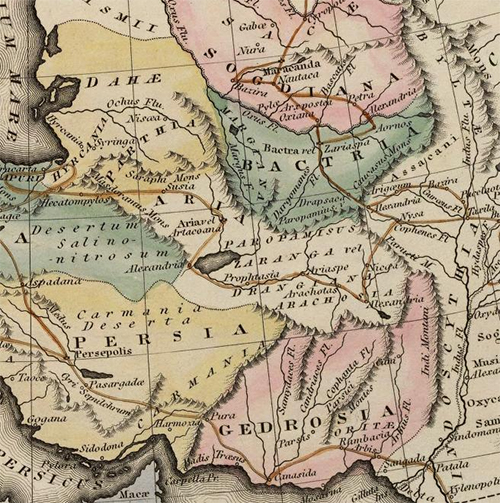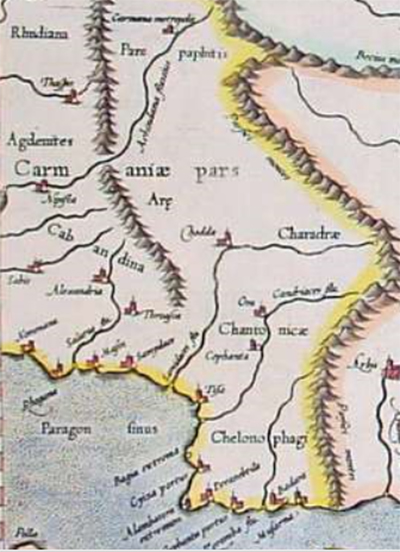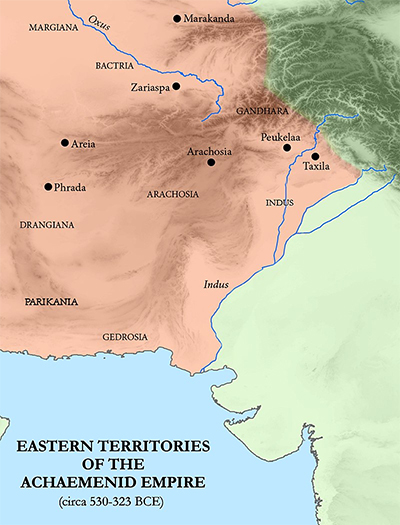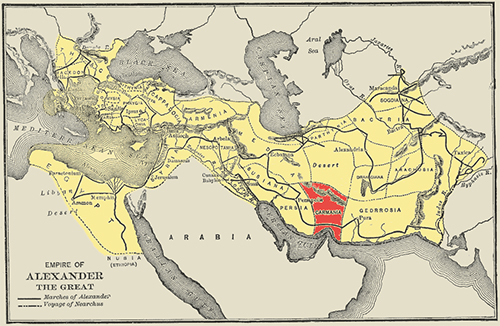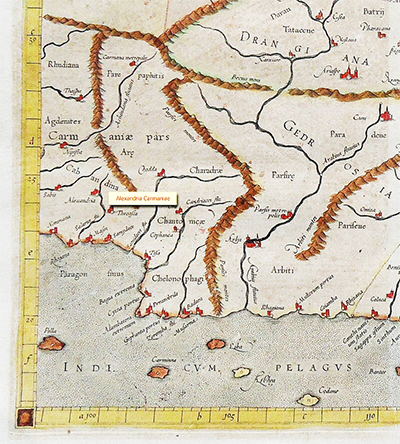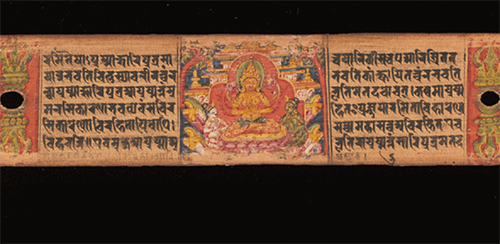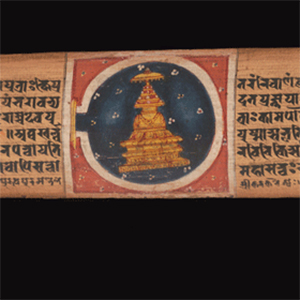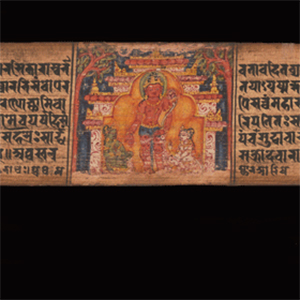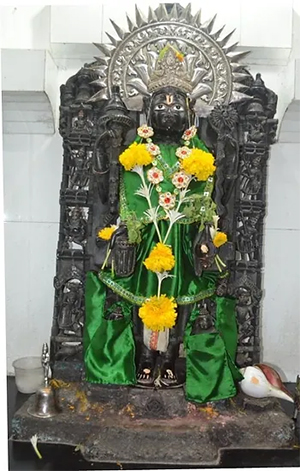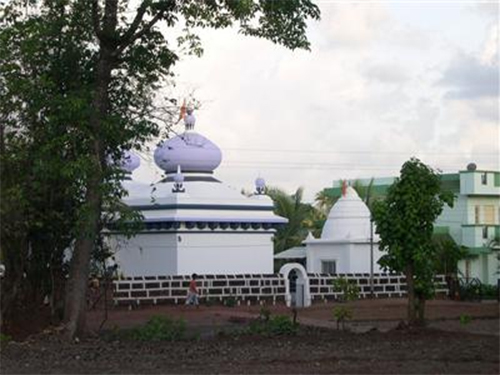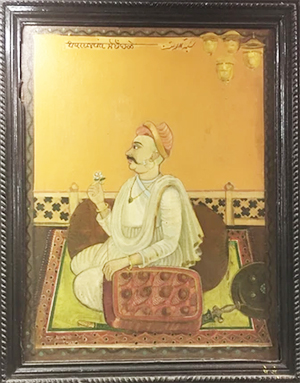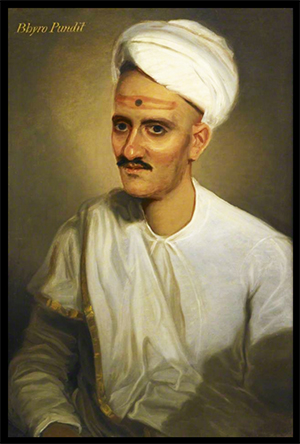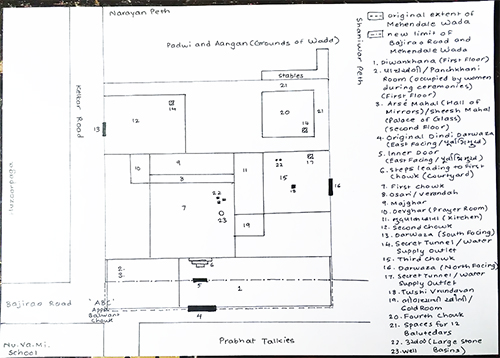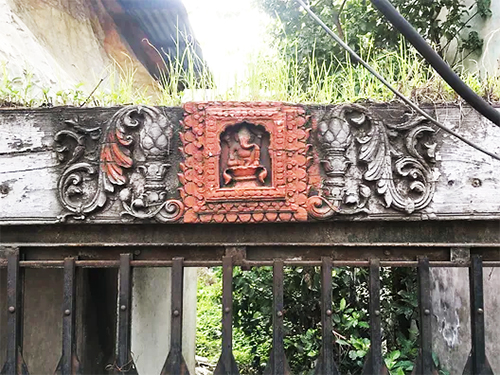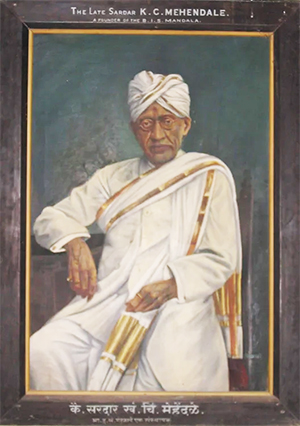Madhavrao IIby Wikipedia
Accessed: 8/24/24
Shrimant Peshwa
Maharajadhiraj
Vakil-ul-Mutlaq (Regent of the Empire)
Madhavrao II
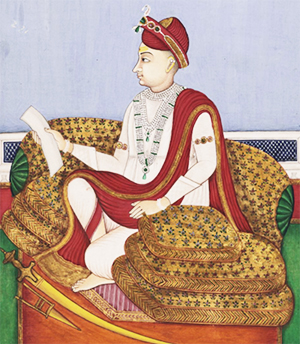 Portrait of Madhavrao II c.1790–1792, 12th Peshwa of the Maratha Confederacy
Portrait of Madhavrao II c.1790–1792, 12th Peshwa of the Maratha ConfederacyIn office: 28 May 1774 – 27 October 1795
Monarch: Rajaram II of Satara
Preceded by: Raghunathrao
Succeeded by: Baji Rao II
Personal detailsBorn: 18 April 1774
Died: 27 October 1795 (aged 21), Shaniwar Wada, Pune, Maratha Empire
Parents: Narayanrao Peshwa (father); Gangabai Sathe (mother)
Relatives: Vishwasrao (uncle); Madhavrao I (uncle); Nanasaheb Peshwa (grandfather); Gopikabai (grandmother)
Residence(s): Shaniwarwada, Pune, Maratha Empire
Profession: Peshwa
Madhavrao II (18 April 1774 – 27 October 1795) was the 12th Peshwa of the Maratha Confederacy, from his infancy. He was known as Sawai Madhav Rao or Madhav Rao Narayan. He was the posthumous son of Narayanrao Peshwa, murdered in 1773 on the orders of Raghunathrao. Madhavrao II was considered the legal heir, and was installed as Peshwa by the Treaty of Salbai[1] in 1782 after First Anglo-Maratha War.Early lifeMain article: Peshwa § Appointed_and_Hereditary_Peshwas
Madhavrao II was the posthumous son of Peshwa Narayanrao by his wife, Gangabai.
After Narayanrao's murder by Raghunathrao's supporters, he became the Peshwa. But he was soon deposed by Nana Phadnavis and 11 other administrators in what is called "The Baarbhaai Conspiracy" (Conspiracy by the Twelve). Raghunathrao was tried, convicted, and sentenced to death by the justice Ram Shastri Prabhune but the sentence was never carried out. They instead installed Gangabai's newborn son, Madhavrao II, as the Peshwa. The twelve then formed a council of the state known as the Bara Bhai for the conduct of the affairs of the state in the name of the new Peshwa, Sawai Madhav Rao, as he was made Peshwa when he was barely 40 days old. His time in power was dominated by the political intrigues of Nana Fadnavis.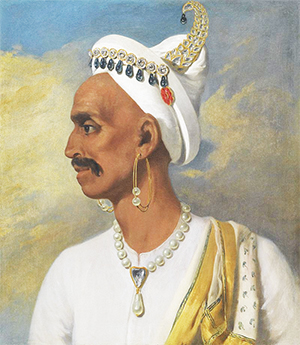 Portrait of Nana Fadnavis by John Thomas Seton
Portrait of Nana Fadnavis by John Thomas SetonNana Fadnavis; also Phadnavis and Furnuwees and abbreviated as Phadnis) (12 February 1742 – 13 March 1800), born Balaji Janardan Bhanu, was a Maratha minister and statesman during the Peshwa administration in Pune, India. James Grant Duff states that he was called "
the Maratha Machiavelli" by the Europeans.
-- Nana Fadnavis, by Wikipedia
Reign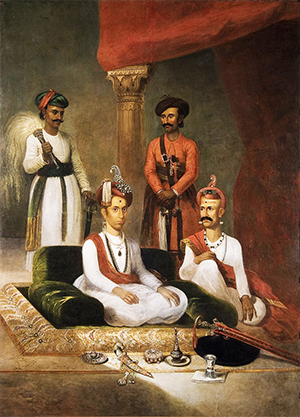 Madhav Rao Narayan with Nana Fadnavis.First Anglo-Maratha WarAfter the British loss in 1782 in the First Anglo-Maratha War, Mahadji Shinde got Madhvrao recognized as Peshwa by the British. However, all powers of the Peshwa were in the hands of ministers like Nana Fadnavis, Mahadaji Shinde and others.
Madhav Rao Narayan with Nana Fadnavis.First Anglo-Maratha WarAfter the British loss in 1782 in the First Anglo-Maratha War, Mahadji Shinde got Madhvrao recognized as Peshwa by the British. However, all powers of the Peshwa were in the hands of ministers like Nana Fadnavis, Mahadaji Shinde and others.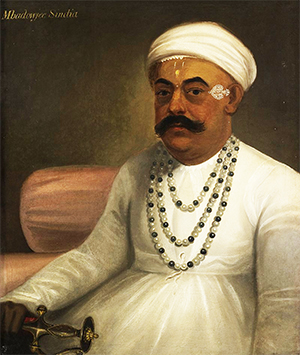 Mahadaji Shinde (23 December 1730 – 12 February 1794), later known as Mahadji Scindia or Madhava Rao Scindia, was a Maratha statesman and general who served as the Raja of Gwalior from 1768 to 1794. He was the fifth and the youngest son of Ranoji Rao Scindia, the founder of the Scindia dynasty. He is reputed for having restored the Maratha rule over North India and for modernizing his army.Mahadji was instrumental in resurrecting Maratha power in North India after the Third Battle of Panipat in 1761, and rose to become a trusted lieutenant of the Peshwa, leader of the Maratha Confederacy. Along with Madhavrao I and Nana Fadnavis, he was one of the three pillars of Maratha Resurrection. During his reign, Gwalior became the leading state in the Maratha Confederacy and one of the foremost military powers in India. After accompanying Shah Alam II to Delhi in 1771, he restored the Mughal Empire in Delhi and became the Naib Vakil-i-Mutlaq (Deputy Regent of the Empire). Mahadji Shinde's principal advisors were all Shenvis.
Mahadaji Shinde (23 December 1730 – 12 February 1794), later known as Mahadji Scindia or Madhava Rao Scindia, was a Maratha statesman and general who served as the Raja of Gwalior from 1768 to 1794. He was the fifth and the youngest son of Ranoji Rao Scindia, the founder of the Scindia dynasty. He is reputed for having restored the Maratha rule over North India and for modernizing his army.Mahadji was instrumental in resurrecting Maratha power in North India after the Third Battle of Panipat in 1761, and rose to become a trusted lieutenant of the Peshwa, leader of the Maratha Confederacy. Along with Madhavrao I and Nana Fadnavis, he was one of the three pillars of Maratha Resurrection. During his reign, Gwalior became the leading state in the Maratha Confederacy and one of the foremost military powers in India. After accompanying Shah Alam II to Delhi in 1771, he restored the Mughal Empire in Delhi and became the Naib Vakil-i-Mutlaq (Deputy Regent of the Empire). Mahadji Shinde's principal advisors were all Shenvis.Mahadji Shinde Fought about 50 Battles In His Lifetime against various opponents. He defeated the Jats of Mathura and during 1772-73 Pashtun Rohillas in Rohilkhand and captured Najibabad. His role during the First Anglo-Maratha War was greatest from the Maratha side since
he defeated the British in the Battle of Wadgaon which resulted in the Treaty of Wadgaon and then again in Central India, single handed, which resulted in the Treaty of Salbai in 1782, where he mediated between the Peshwa and the British.-- Mahadaji Shinde, by Wikipedia
This resulted in the Treaty of Salbai, which was signed on 17 May 1782, and was ratified by
[Warren] Hastings in June 1782 and by Nana Phadnavis in February 1783. The treaty ended the First Anglo-Maratha War, restored the status quo, and established peace between the two parties for 20 years.[2]: 63 [3]
Involvement in Anglo-Mysore WarsMain article: Maratha–Mysore Wars
Mysore had been attacking the Maratha Confederacy since 1761.
To counter the menace presented by Mysore's Hyder Ali and Tipu Sultan the Peshwa supported the English.
The Maratha-Mysore War ended after the final conflict during the siege of Bahadur Benda in January 1787, and later settled for peace with the kingdom of Mysore, to which Tipu Sultan obliged with the signing of the treaty of Gajendragad in April 1787.
Tipu had to pay an annual tribute of 12 lakhs per year to the Marathas, thus ending hostilities with them, which allowed him to focus on his rivalry with the British. The Battle of Gajendragadh was fought between the Marathas and Tipu Sultan from March 1786 to March 1787 in which Tipu Sultan was defeated by the Marathas. By the victory in this battle, the border of the Maratha territory extended till Tungabhadra river.[4][5]
Maratha-Mysore war ended in April 1787, following the finalizing of treaty of Gajendragad, as per which, Tipu Sultan of Mysore was obligated to pay 4.8 million rupees as a war cost to the Marathas, and an annual tribute of 1.2 million rupees. In addition to returning all the territory captured by Hyder Ali,[6][7] Tipu also agreed to pay 4 year's arrears of the tribute, which Mysore owed to the Marathas, through Hyder Ali.[8]Tipu would release Kalopant and return Adoni, Kittur, and Nargund to their previous rulers. Badami would be ceded to the Marathas.
Tipu would also pay an annual tribute of 12 lakhs per year to the Marathas. In return, Tipu would get all the places that they had captured in the war, including Gajendragarh and Dharwar. Tipu would also be addressed by the Marathas by an honorary title of "Nabob Tipu Sultan, Fateh Ali Khan".[9][10]
During the Third Anglo-Mysore War the British East India Company was alarmed by the strength and the gains made by the Maratha Confederacy not just against Mysore but also in India.Chaos in Delhi, Mughal DarbarIn 1788, Isma'il Beg, a Persian who served as a general in the Mughal army along with a few hundred Mughal-Rohilla troops led a large-scale revolt against the Marathas, who dominated North India at the time. However, the revolt was immediately crushed and Isma'il Beg was defeated and executed by the Scindian armies. Thereafter, a Rohilla warlord named Ghulam Qadir, descendant of the infamously treacherous Najib-ud-Daualh and an ally of Isma'il Beg, captured Delhi, capital of the Mughals and deposed and blinded the Mughal emperor Shah Alam II, placing a puppet on the imperial throne. He unleashed untold atrocities on the royal family and common populace, slaughtering thousands and looting about 22 Crores. However, on 2 October 1788, Mahadji Scindia, upon hearing this news, quickly re-assembled his army and captured Delhi, torturing and eventually, killing Ghulam Qadir and restoring Shah Alam II to the throne.[11][12][13]
Subjugation of RajputIn 1790, the Mahadji Shinde won over Rajput States in the Battle of Patan & Battle of Merta. After the death of Mahadaji Shinde In 1794, the Maratha power got concentrated in the hands of Nana Fadnavis.[14]
Defeat of NizamMain article: Battle of Kharda
The Battle of Kharda took place in February 1795 between the Nizam of Hyderabad, Asaf Jah II, and Peshwa Madhavrao II, in which the Nizam was badly defeated.
Governor General John Shore followed the policy of non-intervention despite the fact that the Nizam was under his protection. This led to the loss of trust with British and the rout of the Hyderabad army. This was the last battle fought by all Maratha chieftains together.Doji bara famineThe oldest famine in Deccan with local documentation sufficiently well-preserved for analytical study is the Doji bara famine of 1791–1792.[15] Relief was provided by the ruler, the Peshwa Sawai Madhavrao II, in the form of imposing restrictions on export of grain and importing rice in large quantities from Bengal[16] via private trading,[15] however the evidence is often too scanty to judge the 'real efficacy of relief efforts' in the Mughal period.[17]ZooMadhavrao was fond of the outdoors and had a private collection of exotic animals such as lions and rhinos.
The area where he hunted became later the Peshwe Park zoo in Pune. He was particularly fond of his herd of trained dancing deer.[18]DeathMadhavrao committed suicide at the age of 21 by jumping off from the high walls of the Shaniwar Wada in Pune.[19] 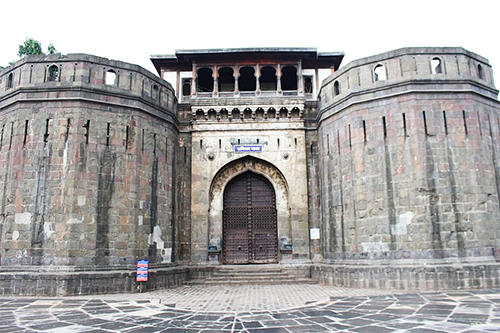
Shaniwar Wada is a historical fortification in the city of Pune, India. Built in 1732, it was the great seat of the Peshwas of the Maratha Empire until 1818. Following the rise of the Maratha Empire, the palace became the center of Indian politics in the 18th century. The fort itself was largely destroyed in 1828 by an unexplained fire, but the surviving structures are now maintained as a tourist site.
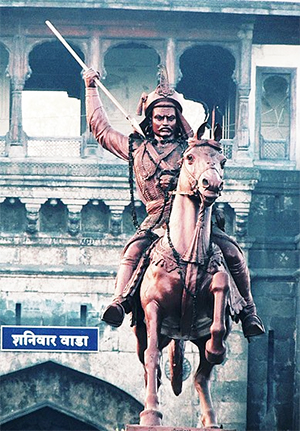 An equestrian statue of Peshwa Baji Rao I, Prime Minister of the Maratha Empire, in the Shaniwar Wada complex. He was the first resident of the fortified palace.The Shaniwar Wada was normally the seven-story capital building of the Peshwas of the Maratha Empire. It was supposed to be made entirely of stone. However, after the completion of the base floor or the first story, the people of Satara (the national capital) complained to the Chhatrapati Shahu I (Emperor) saying that a stone monument can be sanctioned and built only by the emperor himself and not the Peshwas. Following this, an official letter was written to the Peshwas stating that the remaining building had to be made of brick and not stone.
An equestrian statue of Peshwa Baji Rao I, Prime Minister of the Maratha Empire, in the Shaniwar Wada complex. He was the first resident of the fortified palace.The Shaniwar Wada was normally the seven-story capital building of the Peshwas of the Maratha Empire. It was supposed to be made entirely of stone. However, after the completion of the base floor or the first story, the people of Satara (the national capital) complained to the Chhatrapati Shahu I (Emperor) saying that a stone monument can be sanctioned and built only by the emperor himself and not the Peshwas. Following this, an official letter was written to the Peshwas stating that the remaining building had to be made of brick and not stone.By 1758, at least a thousand people lived in the fort. In 1773, Narayanrao, who was the fifth and ruling Peshwa then, was murdered by guards on orders of his uncle Raghunathrao and aunt Anandibai. A popular legend has it that Narayanrao's ghost still calls for help on full moon nights. Various people, working around the area, have allegedly reported the cries of "Kaka mala vachava" (Uncle, save me) by Narayanrao Peshwa after his death.
In June 1818, the Peshwa, Bajirao II, abdicated his Gaadi (throne) to Sir John Malcolm of the British East India Company and went into political exile at Bithoor, near Kanpur in present-day Uttar Pradesh, India. On 27 February 1828, a great fire started inside the palace complex. The conflagration raged for seven days. Only the heavy granite ramparts, strong teak gateways and deep foundations and ruins of the buildings within the fort survived.
-- Shaniwar Wada, by Wikipedia
The cause of the suicide probably was that he could not endure the highhandedness of Nana Fadnavis. Just before his suicide, it is said that in ordering the execution of the despised police commissioner, Ghashiram Kotwal, Madhavrao was able to defy the wishes of Nana for the first time.[20]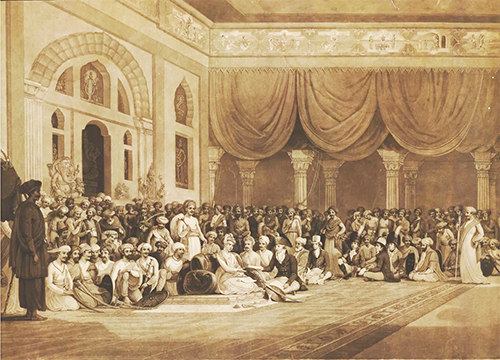 A Representation of the delivery of the Ratified Treaty of 1790 by Sir Chas Warre Malet Bart to His Highness Soneae Peshwa, in full Durbar or Court as held upon that occasion at Poonah in the East Indies on 6 July 1790Succession
A Representation of the delivery of the Ratified Treaty of 1790 by Sir Chas Warre Malet Bart to His Highness Soneae Peshwa, in full Durbar or Court as held upon that occasion at Poonah in the East Indies on 6 July 1790SuccessionPeshwa Sawai Madhavrao II died in 1795 with no heir. Therefore, he was succeeded by Raghunathrao's son, Baji Rao II.
See also• Nana Fadnavis
• Mahadaji Pant Guruji
• Mahadaji Shinde
• Narayan Rao
References1. Thorpe, S.T.E. (2009). The Pearson General Studies Manual 2009, 1/e. Pearson Education. p. 96. ISBN 9788131721339. Retrieved 12 October 2014.
2. Naravane, M. S. (2006). Battles of the Honourable East India Company: Making of the Raj. APH Publishing. ISBN 978-81-313-0034-3.
3. "Anglo-Maratha Wars" (PDF). Noida International University. Retrieved 18 July 2024.
4. Hasan, Mohibbul (2005). History of Tipu Sultan. Aakar Books. ISBN 9788187879572.
5. Naravane, M.S. (2014). Battles of the Honorourable East India Company. A.P.H. Publishing Corporation. p. 175. ISBN 9788131300343.
6. Naravane, M. S (1 January 2006). Battles of the Honourable East India Company: Making of the Raj. APH. ISBN 978-81-313-0034-3.
7. Anglo-Maratha relations, 1785-96
8. Sailendra Nath Sen (1994). Anglo-Maratha Relations, 1785-96, Volume 2. Popular Prakashan. ISBN 9788171547890.
9. Hasan, Mohibbul (2005). History of Tipu Sultan. Aakar Books. ISBN 978-81-87879-57-2.
10. Sen, Sailendra Nath (1994). Anglo-Maratha Relations, 1785-96. Popular Prakashan. ISBN 978-81-7154-789-0.
11. Sarkar 1952, p. 323.
12. Malik 1982, p. 565.
13. Sarkar 1952, pp. 329–330.
14. Dikshit, M. G. (1946). "Early Life of Peshwa Savai Madhavrao (Ii)". Bulletin of the Deccan College Research Institute. 7 (1/4): 225–248. JSTOR 42929386.
15. Bombay (India : State) 1883, p. 105.
16. Bombay (India : State) 1885, p. 85.
17. Drèze 1991, p. 12.
18. Parasanisa, Dattatraya Balavanta (1921). Poona in Bygone Days. Bombay: Times Press.
19. Marathas (Peshwas)
20. Kotani, H., 2005. The Death of Ghasiram Kotwal: Power and Justice in the Maratha Kingdom. Minamiajiakenkyu, 2004(16), pp.1-16.[1]
Works cited• Bombay (India : State) (1883). Gazetteer of the Bombay Presidency: Nasik. Vol. 16. Bombay: Printed at the Govt. Central Press.
• Bombay (India : State) (1885). Gazetteer of the Bombay Presidency: Poona. Printed at the Government Central Press.
• Drèze, Jean (1991), "Famine Prevention in India", in Drèze, Jean; Sen, Amartya (eds.), The Political Economy of Hunger: Famine prevention, Oxford: Oxford University Press US, pp. 32–33, ISBN 978-0-19-828636-3
• Malik, Zahiruddin (1982). "Persian Documents pertaining to the tragic End of Ghulam Qadir Rohilla, 1780–1789". Proceedings of the Indian History Congress. 43: 565–571. ISSN 2249-1937. JSTOR 44141288.
• Sarkar, Jadunath (1952). Fall of the Mughal Empire. Vol. III (2 ed.). Calcutta: M. C. Sarkar & Sons.
External links• Jayapalan, N. (2001). History of India. Atlantic Publishers & Distributors (P) Limited. p. 79. ISBN 9788171569281. Retrieved 12 October 2014.


